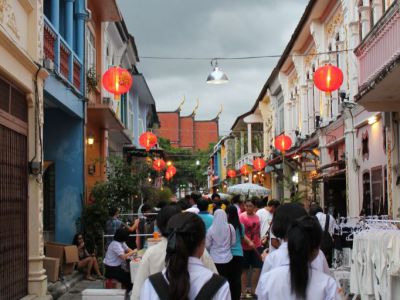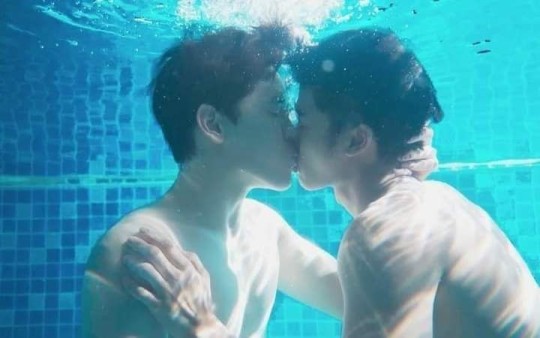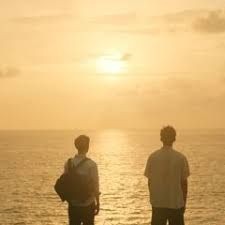STREET ART. PHOTOGRAPHY. MOVIES. MUSIC. AESTHETIC ABSTRACTS.
Don't wanna be here? Send us removal request.
Text
I TOLD SUNSET ABOUT YOU

source: pinterest.com
If the West had Call Me By Your Name, the movie adaptation of the book by Andre Aciman that goes by the same name, Thailand debuted its own series, drawing unimaginably impossible parallels of a similar plot, but took it to a whole new Asian aesthetic level. Screenwritten and directed by Boss Naruebet Kuno, under the production house called Nadao Bangkok, this series features rumored partners in real life, Billkin Putthipong Assaratanakul and PP Krit Amnuaydechkorn, aka BKPP The Series.
It’s a bare minimum story. Teh and Oh-aew were best friends, until a boyhood line of reasoning, turned them into rivals. Years later as they're preparing for university admissions, both pursuing interests in the field of Communication Arts, the two meet in a Chinese language class. Their reunion awakens complicated and unstable feelings.

Shot in Old Town Phuket, that has its own history of Chinese influence, the story takes us through a maze concocted just around that. Our protagonists rivalling to top their Chinese lessons. History is so gracefully blended in a story through all symbols that the director uses, one with an unobservant eye might just end up missing on it.
The first scene opens with Teh singing a Chinese song, with flashbacks from his childhood, where he recalls losing his best friend over a role in a Chinese play, organized by their school for the Chinese New Year. The recurring Chinese proverbs, reiterated Chinese inclinations remain a proof of the screenwriter’s detailed research on the town they shot it in. The series carries as much Chinese heritage as Old Town Phuket does.

source: pinterest.com
There is this constant play of Chinese symbolism, so, so beautifully embedded in taking the story forward. The protagonists realize their feelings for each other while taking Chinese lessons, especially at Teh’s house, the architecture, an acute Chinese home in Phuket, with a restaurant below, selling Hokkian Noodles. Shot at one of the prettiest beaches in Phuket, at wee hours nearing dawn, we observe Teh and Oh-Aew courting each other, in silence, fingers playing with Chinese Rose petals, painting each other’s nails in vermillion.
The choice of this particular flower, represents the androgynous nature of a China Rose, where a flower bears both the male and female reproductive organs in one; meaning, how one could love without basing their feelings on the sex of their partner, that love is for all. You could love anyone you liked, male, female or the other. This flower would also later be used to represent Oh discovering his sexuality, where he’s inclined toward femininity.

source: pinterest.com
Their first kiss is underwater. The scene is shot in such a magnificent way, where they’re kissing deep inside water, but the water on the surface remains still. It could be inferred in so many different ways, where one is hiding their sexuality from the world and yet there is a hurricane circling under water. That even when you do wish to negate it, the ripples underwater shall bubble up to the surface, one fine day.

source: pinterest.com
In a scene where there is a final outflow of powerful feelings, lying dormant in fear of facing them, in fear of rejection from the society, Teh and Oh-Aew give in to their attraction. They had loved each other for so, so long, behind closed doors, just as under the sea water, they could finally give away. There is however a catch in it again, the windows of Teh’s room are open. An impeccable mastery in direction later revealing how these open windows meant they were now perhaps at a threshold of acceptance, accepting their love, their sexuality, their own selves.

source: pinterest.com
The above scene has to remain the most powerful of all. We see Oh bawling in confusion, because Teh had wanted to hold his breasts just as he would have if Oh were a girl, and when Teh finds nothing to grab on, reality comes crashing down and Teh leaves.
And then here we see Oh, clad in a red, lacy bra, wishing if may be he were a girl, Teh would want to kiss him, hold him, love him. This is such an intimate and bold exhibition of confused sexuality in the art of theatre, it leaves the audience astounded.

source: pinterest.com
The final scene is a sight to behold. All their prayers at the Chinese monastery, all the meltdowns and confusion take a final leap to end at Teh saying the final, favorite words a fan would wish to hear,
“If I could be anything, can I be your boyfriend?” They finally do tell the sunset about each other.
Thai BL industry has been venturing into Asian entertainment markets with their business plots of boy love stories, the origins of which can be found in the Japanese yaoi, homoerotic love stories written by women. Even when a product of fantasy, these series have been a breakthrough at representing LGBTQ relationships, fitting themselves into the heteronormative society.
And well, if you haven’t watched ITSAY yet, go watch it now.
26 notes
·
View notes
Text
VERSIFYING STREET ART: NEELIM MAHANTA

source: facebook.com/mahantaneelim
I was sat under a dim lit café when he'd entered, clad in paint, curly hairs a messy hue- in antsy seconds of uncurling toes, we'd greeted a civil hug and a rush of smelling cans of colors washed over the cabin. A mundane August evening had somehow travelled trains on hued tracks; having read enough about him, watched enough interviews on Mahanta, I knew he'd speak in condensed words, sentences strung in drowning, galvanized words. Perhaps that's the thing about art, you don't need words too many to articulate. One stroke of an experienced brush and there you have a whole thousand paged novel screaming its words at you, in abstracts and in linearity.

source: facebook.com/mahantaneelim
Neelim Mahanta turned a household name with his impression of Zubeen Garg on the wall which landed him a feature on the musician’s music video Silaa. Today he might just be the only graffiti artist Assam has.
When asked if poetry and art could begin within similar roots of concoction, he’d said yes. “I believe poetry could be a catalyst to art and vice versa. For those who find art too complicated to conceive can perhaps read a piece of poetry defining that art piece and then understand. Language helps” Speaking of the art scenario in Assam, Mahanta says, “People here for some reason or the other, fear art. It could be because they don’t understand or may be because there was no artistic environment to help develop their interests toward art.” Through his ventures as a team called The Living Art, this is exactly what Mahanta plans on turning tables at; teaching young school going children how to paint, so they grow up perceiving a world in its innate bountiful beauty.

source: facebook.com/mahantaneelim
If his abstracts are any evidence, Mahanta himself agrees toward an inclination in drawing inspirations from Einstein. Plumerias are his favorite flowers, because these plants bear intricate structural physiognomy. Of the probable existential gap between what he perceives from nature and what breathes on his palette, he’d said, “I try to make it relatable, more aesthetic, in a manner where people get that yes, that is a tree he drew there but can also appreciate my manner of exaggeration if you’d call it so.”

source: facebook.com/mahantaneelim
“Brokenness,” he says “is beautiful”, when I’d asked him if these glasses we were downing our beers with, could perhaps look prettier scattered on the floor. “I love ruins too!” I’d said and he replied, “And I love painting on those ruined walls.” “I would love it so much to body paint on live models,” he says, MF Hussain being one of his many inspirations, “only if circumstances were intimate enough to form that artistic preview.” He just as plainly said, “Be one for me,” when I’d told him the plot from The Vegetarian by Han Kang, and was adamant on having orchids painted on my chest. “This cigarette smoke makes me wish to paint you!”
Art to Mahanta is an escapade, a catharsis and also his way of giving his people back. “I wish to make art available for all. Everyone deserves hues and love.”
There’s always a subtle mix of social reform in his walls washed in paint, sometimes loud and clear, other days silent and screaming.

source: facebook.com/mahantaneelim
Speaking of the artistic scenario in Assam, Mahanta says things are evolving. “On days when I’m painting down the rain, there are people now, the locals, carrying ladders and snacks for me. They try and preserve what I paint, even when they might not wholly understand it.”

source: facebook.com/mahantaneelim
When I asked if he’d may be want to own a gallery someday, he’d said, “I already have one. This big open gallery, down the sky. I hope you all do visit sometime.”
Mahanta records his artistic journeys and his methods on his Vlog at his YouTube channel. youtu.be/enP0tQRGlks One may journey free on his ventures through his Instagram page and pray for more such beer dates, just as my one August evening.

source: instagram.com/mahanta_livingart/
1 note
·
View note